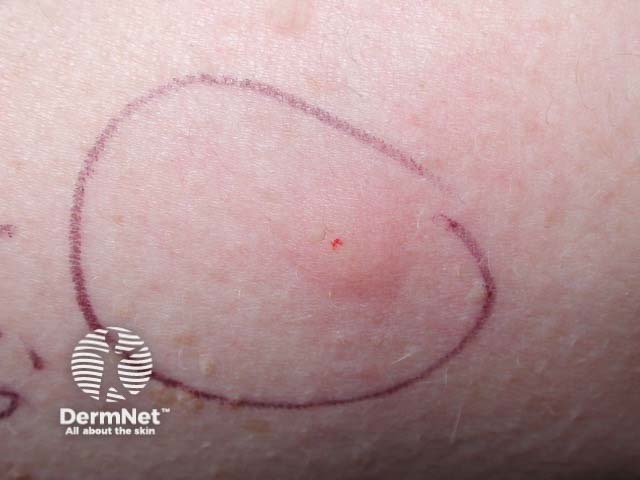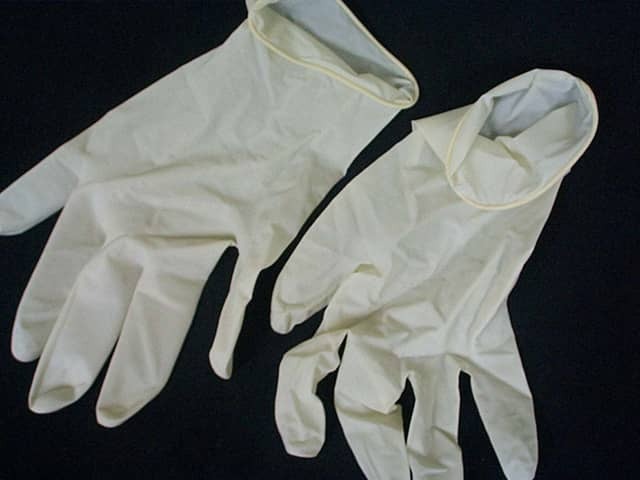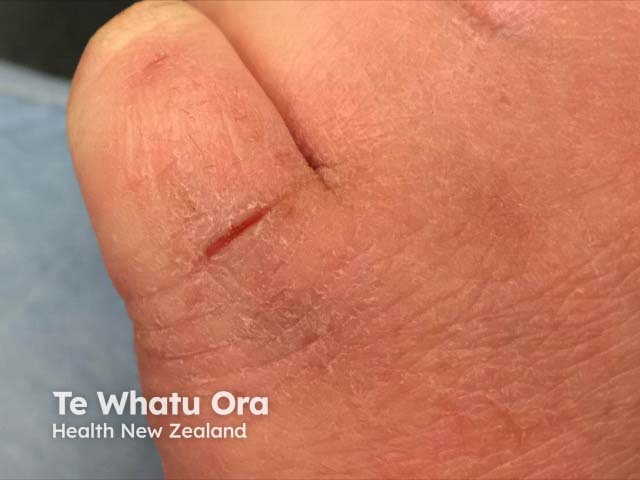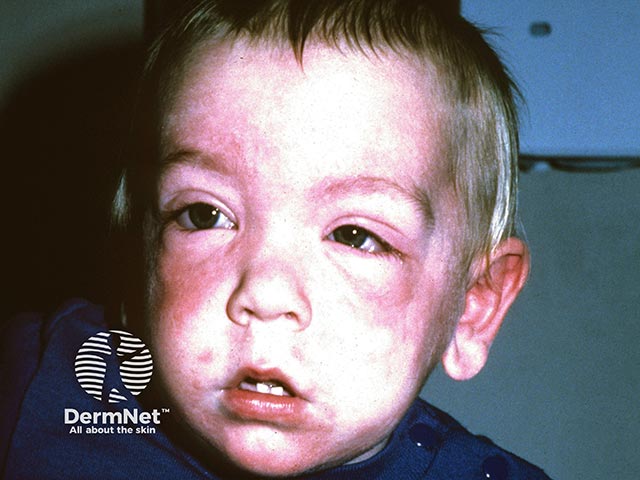Main menu
Common skin conditions

NEWS
Join DermNet PRO
Read more
Quick links
Latex allergy — extra information
Latex allergy
Last Reviewed: November, 2024
Author(s): Dr Zena Al-Ani, Auckland City Hospital, New Zealand (2024)
Previous contributors: Hon A/Prof Amanda Oakley, Dermatologist (2003)
Reviewing dermatologist: Dr Ian Coulson.
Edited by the DermNet content department.
Introduction
Demographics
Causes
Clinical features
Variation in skin types
Complications
Diagnosis
Differential diagnoses
Treatment
Prevention
Outcome
What is latex allergy?
Over 90% of natural rubber comes from the latex, or the milky sap, of the rubber tree, Hevea brasiliensis. Latex can cause reactions ranging from rashes to anaphylaxis.
Latex is ubiquitous in healthcare. It is most commonly used in medical and surgical gloves and also in catheters, balloons, IV tubing, respirators, other medical and dental devices, and condoms. Latex allergy is among the most common causes of anaphylaxis in the operating room.
Natural latex rubber is also found in other products such as toys, erasers, sports equipment, clothing, and elastic bands.

A positive latex prick test

A latex-containing glove

Latex protein rather than the rubber accelerators in a rare type IV allergen

An immediate type 1 reaction after exposure to a rubber balloon; the cheeks and lids have swollen in the last 10 minutes
Who gets latex allergy?
Anyone who is exposed to latex is at risk of becoming sensitised; fortunately, the majority of people do not.
Risk factors include:
- Occupational eg, rubber-industry workers, healthcare workers (from frequent use of latex gloves), housekeepers, hairdressers
- Use of catheters and other latex devices for congenital urinary anomalies eg, children with spina bifida
- Multiple medical/surgical procedures
- History of non-medication-related anaphylactic reactions during anaesthesia
- History of food sensitivities such as banana, avocado, chestnut, tomato, peach, or kiwifruit
- An atopic predisposition.
The prevalence of latex allergy in the general population has been estimated at approximately 4.3%. However, in high-risk populations increased prevalence has been reported eg, around 9.7–12.4% in healthcare workers, and up to 40–65% in paediatric spina bifida patients.
What causes latex allergy?
For reasons not yet understood, some people can become allergic to certain constituents of the latex molecule. Once allergic, sensitivity remains lifelong. There are hundreds of different chemicals within natural latex, but 15 are thought to be responsible for most reactions (Hev b1 to Hev b15).
Latex reactions can be triggered by several modes of exposure, including:
- Direct contact with the skin
- Entrance through mucous membranes
- Parenteral
- Intravenous
- Inhalation (of latex powder).
The surge in demand for latex gloves in the 1980s, driven by new recommendations for use amid the HIV epidemic, led to shortcuts in product cleansing during manufacturing, resulting in gloves with higher allergenic potential.
A true latex allergy will result in a type I hypersensitivity reaction mediated by IgE antibodies that bind to the allergenic latex proteins. The binding triggers mast cells and basophils to release histamine, leukotrienes, prostaglandins, and kinins, resulting in an immune response.
During latex processing, chemical antioxidants are added, which can also cause delayed type IV hypersensitivity reactions (such as thurams, and carbamates). True type IV allergy to latex is reported but much less common than type I reactions
See also: Allergies explained.
What are the clinical features of latex allergy?
The common manifestations of latex sensitivity are:
- A type I (immediate-type hypersensitivity) reaction — can cause contact urticaria (hives) and asthma; and more rarely, anaphylaxis
- A type IV (delayed-type hypersensitivity) reaction resulting in contact dermatitis.
Type I reactions
Immediate-type hypersensitivity requires previous sensitisation and is the most potentially dangerous reaction to latex. Clinical presentations vary but may include contact urticaria, coryza, conjunctivitis, stinging or burning, asthma, or (with mucosal or parenteral exposure) anaphylaxis. A common cause for asthmatic reactions is powdered gloves due to starch powder picking up latex proteins.
Contact urticaria usually presents with pruritus (itching) and swelling of the skin at the site of contact with latex, for example on the hands from wearing gloves or on the genitals from condom use. Symptoms usually start within 5–15 minutes after contact with the latex product, although onset can be delayed for several hours. Symptoms may continue for hours to days after the latex contact has ceased.
Type IV reactions
Contact dermatitis from latex may take several days to appear. It presents with an itchy, scaly rash, and there may be small blisters if the reaction is acute. The rash usually lasts several days to weeks, or longer if exposure to latex continues.
Contact dermatitis is not generally caused by sensitivity to latex proteins but rather to the chemicals used in the manufacture of the latex product, including antioxidants and rubber accelerators thiuram, carbamates, and mercaptobenzothiazole.
How do clinical features vary in differing types of skin?
It is currently not known if latex allergy is more prevalent in people with lighter or darker skin types.
Allergic contact dermatitis can appear red in some skin types. In darker skin, erythema may be less evident, and affected skin may appear purple or darker than the surrounding skin instead.
What are the complications of latex allergy?
Severe clinical manifestations include bronchospasm, hypotension, cardiorespiratory collapse, and shock. Anaphylactic shock is potentially fatal and occurs most commonly in an intraoperative context. Patients who have had frequent exposure to latex have a higher risk of sensitisation and anaphylaxis.
How is latex allergy diagnosed?
In most cases, a diagnosis of latex allergy can be made from an accurate history and clinical examination.
History-taking should include questions about:
- Reactions or complications during surgical procedures or dental work, other symptoms such as rash or wheeze on exposure to latex (balloon inflation-induced rash and wheeze is a common symptom)
- History of atopy
- Food allergies (especially certain fruits eg, banana and kiwifruit).
There are a number of tests that can confirm latex sensitivity, including:
- Patch tests — for allergic contact dermatitis-type reactions
- Skin prick testing — for contact urticaria-type reactions
- Radioallergosorbent test (RAST), a blood test — not as accurate as the skin tests.
Ensure patients are informed when they have had a suspected latex-related allergic reaction, and recommend referral for consideration of latex allergy testing.
What is the differential diagnosis for latex allergy?
Irritant contact dermatitis can present similarly to a latex allergy, although it is actually a non-immunologic reaction where friction or contact with chemicals results in irritated skin. When immediate reactions occur in settings where latex exposure has occurred, consider that it may be an allergen other than latex that is the responsible culprit.
What is the treatment for latex allergy?
General measures
Patients with latex allergy
Healthcare services should offer a latex-safe environment to patients with known latex allergy.
- No-one in the area should wear powdered natural rubber gloves.
- Non-latex gloves should be used to directly examine the patient.
- Do not inject or withdraw fluid through rubber ports or intravenous lines.
- All-natural rubber latex products that routinely (directly or indirectly) come into contact with mucosa, non-intact skin, and internal bodily spaces (eg, catheters, endotracheal tubes) should be removed or made latex-safe (eg, by covering: blood pressure cuffs used over clothing, stethoscope tubing covered with stockinette).
- Products made of dry-moulded rubber (eg, wheelchair tyres, tool handles) do not need to be removed from the area but precautions should be taken to minimise direct exposure by covering the object or body part exposed (eg, having the patient wear non-latex gloves while self-wheeling a wheelchair).
- Latex-safe meals: avoid foods known to cross-react with antibodies to natural rubber latex (eg, avocado, banana, potato, tomato, papaya, chestnut, or kiwifruit).
- Non-latex safe operating rooms: if unavailable, patients should be scheduled as the first procedure of the day to reduce the build-up of latex allergens.
Latex allergy should be added in patients' clinical notes and a medical alert bracelet may be recommended.
Each ward/department should consider who is likely to be high risk and develop an emergency kit of latex-free products for use. The equipment required will vary and will need to be identified by the clinical area.
Healthcare workers with latex allergy
Employers should be aware of the latex allergy so that necessary measures can be taken.
Avoid contact with latex gloves and products.
- Commonly used latex medical products: rubber gloves; elastic bandages; adhesive tape; urinary catheters; electrode pads; wound drains; stomach and intestinal tubes; urinary collection devices; protective sheets; enema tubing and tips; dental cofferdams; rubber pads; and fluid circulating warming blankets.
- Equipment containing latex includes: haemodialysis and anaesthesia equipment; rubber masks; electrode pads; head straps; rubber tourniquets; rubber nasal-pharyngeal airways; rubber oral-pharyngeal airways; teeth protectors; bite blocks; blood pressure cuffs; rubber breathing circuits; reservoir breathing bags; rubber ventilator hoses and bellows; rubber endotracheal tubes; latex cuffs on plastic tracheal tubes; latex injection ports on intravenous tubing; and certain epidural catheter injection adaptors.
Other suggested measures
- Avoid areas where powder may be inhaled from latex gloves worn by other workers.
- Tell your employer that you have a latex allergy.
- Wear a medical alert bracelet.
- Consult with your doctor to determine whether you should carry auto-injectable adrenaline (epinephrine) in case of accidental latex exposure and anaphylactic shock.
Specific measures
If a reaction occurs, identify and remove the source of the latex exposure.
Management of exposed and symptomatic individuals depends on the type of reaction, and may involve:
- Antihistamines
- Topical steroid application for skin inflammation
- Adrenaline (epinephrine), according to anaphylaxis guidelines.
How do you prevent latex allergy?
Workers in high-risk occupations such as healthcare can help prevent latex sensitivity by:
- Using appropriate work practices to reduce the chance of reactions to latex
- Wearing nitrile or polyurethane gloves where practical; if wearing latex gloves, choose non-powdered options -Using only approved barrier cream if wearing latex gloves, as some creams (eg, oil-based products) can lead to glove deterioration and increase the chance of a reaction
- Washing and drying hands thoroughly after removing latex gloves
- Practicing good housekeeping: frequently clean areas and equipment contaminated with latex-containing dust
- Exercising care when removing latex gloves to reduce the risk of exposure of latex allergens to self and/or colleagues.
For those sensitised to latex, education is crucial for the prevention and early management of allergic reactions, including:
- Information regarding foods likely to cause cross-reactions with latex sensitivity and any products that contain latex
- The importance of notifying healthcare providers about the latex allergy and requesting a latex-safe environment
- Learning to recognise the symptoms of latex allergy: skin rash; urticaria; flushing; itching; nasal, eye, or sinus symptoms; asthma; and (rarely) shock
- Consideration of a medical alert bracelet and self-injectable adrenaline as appropriate.
What is the outcome for latex allergy?
There is currently no cure for latex allergy. Education on products containing latex and safe alternatives is important for avoidance. It is also essential for patients with a latex allergy to let healthcare providers know, to enable provision of a latex-safe environment.
Bibliography
- Binkley HM, Schroyer T, Catalfano J. Latex allergies: a review of recognition, evaluation, management, prevention, education, and alternative product use. J Athl Train. 2003;38(2):133–140. PubMed
- Kumar RP. Latex allergy in clinical practice. Indian J Dermatol. 2012;57(1):66–70. doi: 10.4103/0019-5154.92686. Journal
- Nucera E, Aruanno A, Rizzi A, Centrone M. Latex Allergy: Current Status and Future Perspectives. J Asthma Allergy. 2020;13:385–398. doi: 10.2147/JAA.S242058. Journal
- Parisi CAS, Kelly KJ, Ansotegui IJ, et al. Update on latex allergy: New insights into an old problem. World Allergy Organ J. 2021;14(8):100569. doi: 10.1016/j.waojou.2021.100569. Journal
- Walls RS. Latex allergy: a real problem. Med J Aust. 1996;164(12):707–708. doi: 10.5694/j.1326-5377.1996.tb122264.x. Journal
On DermNet
- Contact urticaria
- Anaphylaxis
- Allergic contact dermatitis
- Allergy to rubber accelerators
- Gloves for hand protection
- Hand care in healthcare workers
- Surgical gloves
- Allergies explained
- Patch tests
- Skin prick testing
Other websites
- Latex — Allergy New Zealand
- Latex Allergy — Anaphylaxis UK
